Entry Database : PDB / ID : 3k22Title Glucocorticoid Receptor with Bound alaninamide 10 with TIF2 peptide Glucocorticoid receptor Transcriptional Intermediary Factor 2 Keywords / / / / / / / / / / / / / / / / / / / / / Function / homology Function Domain/homology Component
/ / / / / / / / / / / / / / / / / / / / / / / / / / / / / / / / / / / / / / / / / / / / / / / / / / / / / / / / / / / / / / / / / / / / / / / / / / / / / / / / / / / / / / / / / / / / / / / / / / / / / / / / / / / / / / / / / / / / / / / / / / / / / / / / / / / / / / / / / / / / / / / / / / / / / / / / / / / / / / / / / / Biological species Homo sapiens (human)Method / / / / Resolution : 2.1 Å Authors Biggadike, K.B. / McLay, I.M. / Madauss, K.P. / Williams, S.P. / Bledsoe, R.K. Journal : Proc.Natl.Acad.Sci.USA / Year : 2009Title : Design and x-ray crystal structures of high-potency nonsteroidal glucocorticoid agonists exploiting a novel binding site on the receptor.Authors: Biggadike, K. / Bledsoe, R.K. / Coe, D.M. / Cooper, T.W. / House, D. / Iannone, M.A. / Macdonald, S.J. / Madauss, K.P. / McLay, I.M. / Shipley, T.J. / Taylor, S.J. / Tran, T.B. / Uings, I.J. ... Authors : Biggadike, K. / Bledsoe, R.K. / Coe, D.M. / Cooper, T.W. / House, D. / Iannone, M.A. / Macdonald, S.J. / Madauss, K.P. / McLay, I.M. / Shipley, T.J. / Taylor, S.J. / Tran, T.B. / Uings, I.J. / Weller, V. / Williams, S.P. History Deposition Sep 29, 2009 Deposition site / Processing site Revision 1.0 Aug 11, 2010 Provider / Type Revision 1.1 Jul 13, 2011 Group Revision 1.2 Sep 25, 2013 Group Revision 1.3 Nov 1, 2017 Group / Category Revision 1.4 Jul 29, 2020 Group Advisory / Data collection ... Advisory / Data collection / Database references / Derived calculations Category chem_comp / database_PDB_caveat ... chem_comp / database_PDB_caveat / struct_ref_seq_dif / struct_site / struct_site_gen Item / _chem_comp.type / _struct_ref_seq_dif.detailsDescription / Provider / Type Revision 1.5 Oct 13, 2021 Group / Structure summary / Category / database_2 / struct_ref_seq_difItem _chem_comp.pdbx_synonyms / _database_2.pdbx_DOI ... _chem_comp.pdbx_synonyms / _database_2.pdbx_DOI / _database_2.pdbx_database_accession / _struct_ref_seq_dif.details Revision 1.6 Feb 21, 2024 Group / Category / chem_comp_bondRevision 1.7 Mar 13, 2024 Group / Structure summary / Category / pdbx_entity_src_syn / Item
Show all Show less
 Yorodumi
Yorodumi Open data
Open data Basic information
Basic information Components
Components Keywords
Keywords Function and homology information
Function and homology information Homo sapiens (human)
Homo sapiens (human) X-RAY DIFFRACTION /
X-RAY DIFFRACTION /  SYNCHROTRON /
SYNCHROTRON /  MOLECULAR REPLACEMENT /
MOLECULAR REPLACEMENT /  molecular replacement / Resolution: 2.1 Å
molecular replacement / Resolution: 2.1 Å  Authors
Authors Citation
Citation Journal: Proc.Natl.Acad.Sci.USA / Year: 2009
Journal: Proc.Natl.Acad.Sci.USA / Year: 2009 Structure visualization
Structure visualization Molmil
Molmil Jmol/JSmol
Jmol/JSmol Downloads & links
Downloads & links Download
Download 3k22.cif.gz
3k22.cif.gz PDBx/mmCIF format
PDBx/mmCIF format pdb3k22.ent.gz
pdb3k22.ent.gz PDB format
PDB format 3k22.json.gz
3k22.json.gz PDBx/mmJSON format
PDBx/mmJSON format Other downloads
Other downloads 3k22_validation.pdf.gz
3k22_validation.pdf.gz wwPDB validaton report
wwPDB validaton report 3k22_full_validation.pdf.gz
3k22_full_validation.pdf.gz 3k22_validation.xml.gz
3k22_validation.xml.gz 3k22_validation.cif.gz
3k22_validation.cif.gz https://data.pdbj.org/pub/pdb/validation_reports/k2/3k22
https://data.pdbj.org/pub/pdb/validation_reports/k2/3k22 ftp://data.pdbj.org/pub/pdb/validation_reports/k2/3k22
ftp://data.pdbj.org/pub/pdb/validation_reports/k2/3k22 Links
Links Assembly
Assembly

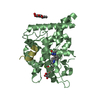
 Components
Components Homo sapiens (human) / Gene: GRL, NR3C1, PGR / Plasmid: pHis GST / Production host:
Homo sapiens (human) / Gene: GRL, NR3C1, PGR / Plasmid: pHis GST / Production host: 
 X-RAY DIFFRACTION / Number of used crystals: 1
X-RAY DIFFRACTION / Number of used crystals: 1  Sample preparation
Sample preparation SYNCHROTRON / Site:
SYNCHROTRON / Site:  APS
APS  / Beamline: 17-ID / Wavelength: 1 Å
/ Beamline: 17-ID / Wavelength: 1 Å molecular replacement
molecular replacement Processing
Processing MOLECULAR REPLACEMENT / Resolution: 2.1→19.85 Å / Cor.coef. Fo:Fc: 0.957 / Cor.coef. Fo:Fc free: 0.933 / WRfactor Rfree: 0.261 / WRfactor Rwork: 0.216 / Occupancy max: 1 / Occupancy min: 0.5 / FOM work R set: 0.696 / SU B: 16.499 / SU ML: 0.221 / SU R Cruickshank DPI: 0.221 / SU Rfree: 0.192 / Cross valid method: THROUGHOUT / σ(F): 0 / ESU R: 0.22 / ESU R Free: 0.191 / Stereochemistry target values: MAXIMUM LIKELIHOOD / Details: HYDROGENS HAVE BEEN ADDED IN THE RIDING POSITIONS
MOLECULAR REPLACEMENT / Resolution: 2.1→19.85 Å / Cor.coef. Fo:Fc: 0.957 / Cor.coef. Fo:Fc free: 0.933 / WRfactor Rfree: 0.261 / WRfactor Rwork: 0.216 / Occupancy max: 1 / Occupancy min: 0.5 / FOM work R set: 0.696 / SU B: 16.499 / SU ML: 0.221 / SU R Cruickshank DPI: 0.221 / SU Rfree: 0.192 / Cross valid method: THROUGHOUT / σ(F): 0 / ESU R: 0.22 / ESU R Free: 0.191 / Stereochemistry target values: MAXIMUM LIKELIHOOD / Details: HYDROGENS HAVE BEEN ADDED IN THE RIDING POSITIONS Movie
Movie Controller
Controller





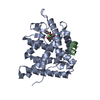


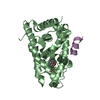
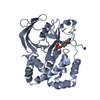
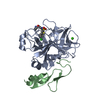
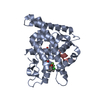

 PDBj
PDBj





















